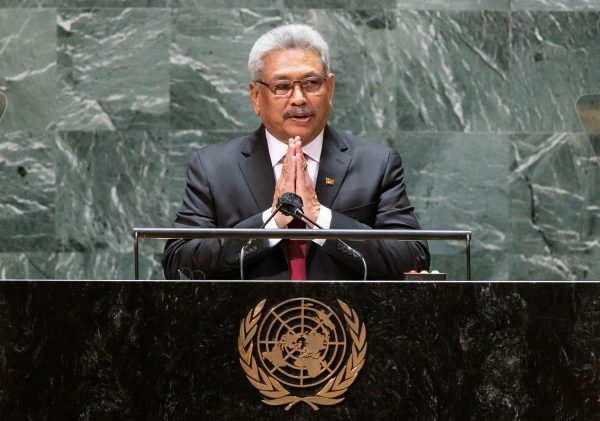2021 was a year that millions will associate with lengthy queues to purchase sugar, milk powder, kerosene and cooking gas. This is because prices skyrocketed to hitherto unseen levels, thanks mainly to a severely indebted island lacking dollars to pay for essential imports. The year ended with around 1500 shipping containers comprising essential items stuck at port because the government had not released dollars to pay for them.
Inflation in December was 12.1 per cent, having risen from 9.9 per cent in November, with food prices having more than doubled in the past year. The government exacerbated inflation by printing money willy-nilly — as much as Rs 69,100 crore (US$3.4 billion) in 2021. With the focus on the dollar crisis, inflation, and food queues, what is not sufficiently covered concerns those going hungry.
The regime was also linked to various scams that worsened conditions. One such scam centred on the propane and butane ratio in cooking gas cylinders, which caused numerous household explosions and killed and injured individuals. Another centred on contaminated fertiliser from China, which the government was forced to return yet pay US$6.7 million for, apparently due to corrupt procurement. In a country now infamous for impunity, no one was held responsible for corruption or incompetence.
Sri Lanka’s foreign currency inflow has long depended on remittances, tourism and specific exports like garments and tea. The COVID-19 pandemic, which has now killed over 15,000 people, was bound to trouble these sectors. While the government oversaw a relatively successful vaccination program, unsustainable debts plus arrogant and fatuous decision making landed the country where it is.
The nearly three decades-long civil war contributed to these debts, but so did ‘blingfrastructure’ projects former president Mahinda Rajapaksa and his Chinese partners initiated. Consequently, Sri Lanka must cough up around US$7 billion in 2022 to various creditors to service its debts, which between now and 2026 will amount to around US$26 billion. The possibility that Sri Lanka may, for the very first time, default on its obligations is the reason Fitch Ratings downgraded it in December. The move raised predictable government hackles, but it reflects the balance of payments crisis facing the island. While COVID-19 exacerbated the balance of payments crisis, debt financing was a pre-COVID-19 predicament.
President Gotabaya Rajapaksa’s decision in April to ban chemical fertiliser was related to this dilemma. Doing so would eliminate US$400 million per year of government fertiliser subsidies. Vistas of Prosperity and Splendor promised an organic agricultural sector within ten years, but this hastily imposed policy negatively impacted farmers. They have since protested unceasingly against the government, joining teachers and others who are also demanding higher wages given the runaway cost of living. It now seems the rice shortage caused by the addle-brained decision to abruptly ban chemical fertiliser, weedicides, and herbicides will likely cost the government US$450 million in rice imports over the next few months.
Rajapaksa’s authoritarian reputation and Sinhalese Buddhist credentials made Tamils and Muslims fear for their future. The continued militarisation of the predominantly Tamil northeast and the ban against burials for those who died from COVID-19 — a policy that especially traumatised Muslims — confirmed their fears. Rajapaksa’s unwillingness to fully investigate the 2019 Easter Sunday Islamist bombings that killed around 270 people, allegedly because forces close to him helped orchestrate the event to promote his election prospects, has also estranged the Christians who voted for him in large numbers.
This and his attentiveness to Buddhist interests aside, the country has thus far not experienced anti-minority violence. Indeed, the difficulties stemming from COVID-19 may have tamed the regime’s rabid majoritarianism. But this was not enough for Sri Lanka to be invited to US President Joe Biden’s Summit for Democracy. Some think cosying up to China, especially under presidents Mahinda and Gotabaya Rajapaksa, was the reason why. In any case, the pro-China tilt took place amid rampant corruption, increased authoritarianism and an unwillingness to account for human rights violations — major themes undergirding the democracy summit.
The Rajapaksa government is slated to announce a new constitution, which will further strengthen the island’s Sinhalese Buddhist character and presidential powers. The government and its allies command a two-thirds parliamentary majority, but today even cabinet ministers excoriate the regime while allies threaten to desert it. At the same time, Rajapaksa effigies are hit during protests and family members are booed in public.
Even government officials now warn of impending food shortages. Overall, the country’s multiple crises cannot be addressed unless the economy is restructured and embraces a more pluralist climate. Those with vested interests, including the Rajapaksa family, find this threatening. Hopelessness is why some ask the military to take over.
Sri Lanka’s military enjoys status and resources, with many retired and serving officers currently benefitting from sinecures. It is unlikely these individuals want to undermine their positions by taking on a debilitated state. They are more likely to further militarisation under Rajapaksa rule, which does not bode well for democracy.
The Rajapaksa family wants to stay in power and build a political dynasty. Their corrupt governance is a major reason for the island’s recent democratic backsliding. On the other hand, various anti-government protests highlight the island’s democratic resilience. This simultaneous fortitude and retreat notwithstanding, the year ahead may see Sri Lanka mired in violence and militarised autocracy. If so, it will be another year of disasters.
Neil DeVotta is a Professor of Politics and International Affairs at Wake Forest University.
This article is part of an EAF special feature series on 2021 in review and the year ahead.


Mostly correct but SL politicians always leave office when they loose elections no matter how dictatorial they are. So violence is out of the question.